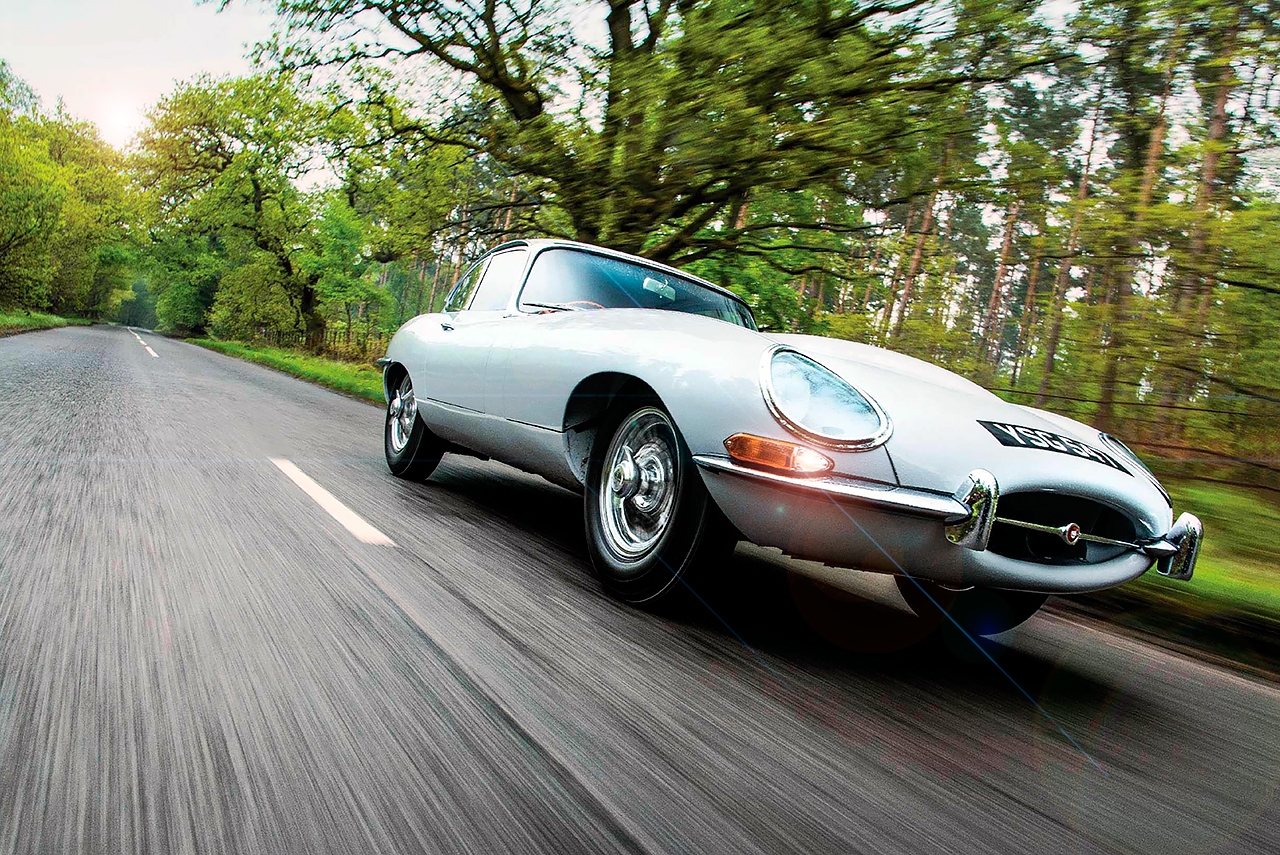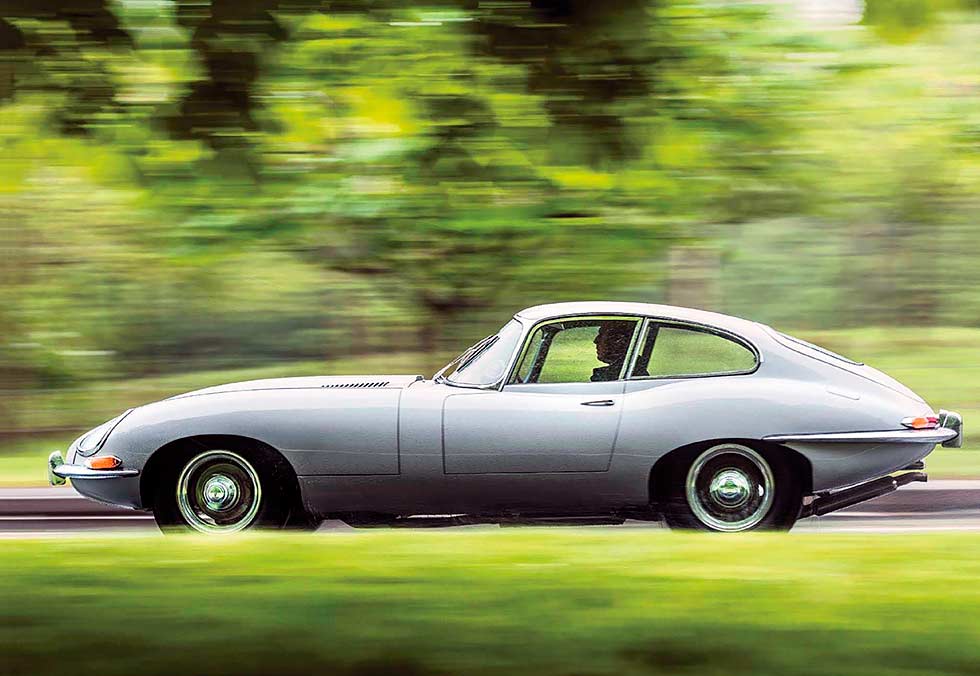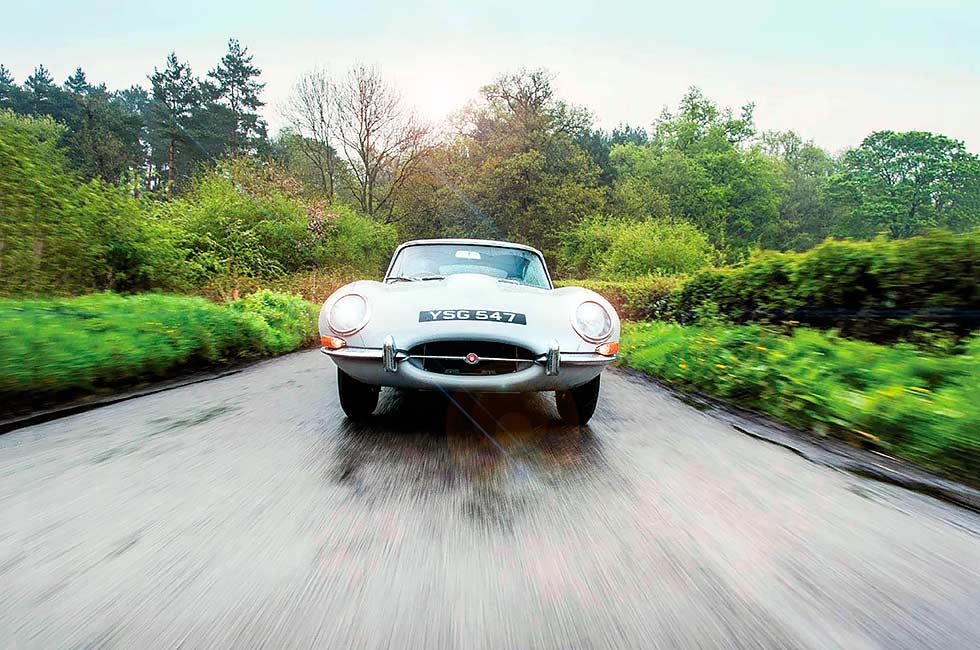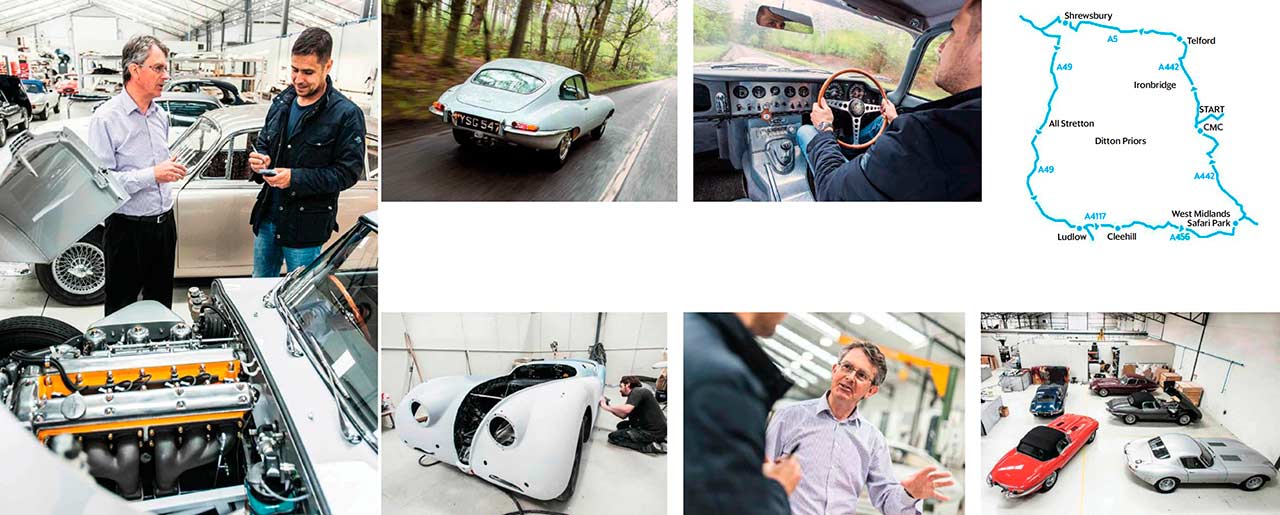
The Pilgrimage. Great drives to meet marque gurus 1961 Jaguar E-type. The snaking A-roads and high-speed blasts are stunning. We try out Jaguar restorer CMC’s 100-mile test-route in its freshly rebuilt E-type coupé, then get to see what goes on behind the workshops’ roller shutter doors. Words Ross Alkureishi. Photography Jonathan Jacob.
The Pilgrimage We follow one of Jaguar specialist CMC’s test routes in the early flat-floor E-type it has just restored, and take a tour of its restoration workshops.
There could only be one car in which to undertake this month’s Pilgrimage – Jaguar E-type chassis #15. I spent an indecent amount of time engaged in visual foreplay with this Pearl Grey car on the Classic Motor Cars stand at the London Classic Car Show back in February, so I called managing director Nick Goldthorp to see if I could borrow it for a test run around the best driving terrain that Shropshire has to offer. Destination: the CMC workshops where the car was reborn after a 2956-hour restoration.
Getting comfortable in this early flat-floor example is easier said than done. The process of folding my 6ft 3in frame behind the wheel is inelegant and once in place my legs are splayed and slightly offset in the tight footwell and my head is brushing the rooflining. The deep leather bucket seats offer encouraging initial support but a lack of rake adjustment suggests the fixed position could cause back-related issues later.
And yet, the cabin demonstrates exactly why the E-type hit the sweet spot upon its 1961 Geneva Motor Show launch – sensuous aesthetics, punchy straight-six performance and a finely finished interior all rolled into one. Combine that with a £2196 asking price – remarkable value compared to contemporary Ferraris and Aston Martins – and it was clear that Browns Lane had produced something special. It’s further enhanced by an epic view down the long bonnet, which drops sinuously out of the driver’s sight and is dominated by a central power bulge and multitude of louvres. The seduction process has begun and I haven’t even fired it up yet.

‘I drop a gear or two, floor the throttle and the big straight-six bares its teeth’
The gearlever is close to hand but requires a touch of elbow hyperextension for it to slot fully home into first – hello again Moss gearbox, my gloriously recalcitrant old friend. I wave goodbye to Nick and we’re off into the lush Shropshire countryside, heading north on the A442 towards Telford. Delightful low-level axle whine dominates at trundling speeds but the three SU HD8 carburettors’ voluble ingestions begin to drown it out as the revs rise.
I push harder on the throttle and the engine responds instantly, growling willingly and vocally as I shift up and down through the ratios. I soon discover that those movements must be measured, though – jumping the gun results in the wince-inducing graunch of moving cog striking moving cog.
Sensible upgrades are deemed perfectly acceptable in the E-type world, but this one has been restored to original specification because it’s such an early and historically significant chassis number. That still means disc brakes – which engage predictably but feel a mite underpowered – but also crossply tyres, which look and feel the part but transmit every road surface nuance to the steering wheel. Hitting the first big imperfection elicits genuine fear – this is a car that demands a firm hand on the wheel at all times.
My plan is to follow a route that CMC quality control manager, Wayne Smallman, uses when he shakes a restored car down. This involves driving it anywhere between 500 and 1000 miles in a variety of driving conditions to ensure that it’s tip-top before its new owner takes delivery. Sounds like the dream job.
Joining the M54, it’s time to see what it can really do. I drop a gear or two, floor the throttle and the big straight-six bares its teeth. I’ve got a genuine 265bhp to play with today – a figure that was really just an optimistic claim made by Jaguar back in the day – together with 260lb ft of torque. The later 4.2-litre unit may have more torque but this 3.8-litre original is definitely the sweeter of the two. The 0-60mph sprint takes a whisker under seven seconds and the big car feels utterly planted at high speeds.
The lack of overdrive remains a surprise but it devours motorway miles in a thoroughly composed manner – broken only by my repeated heavy bursts of acceleration just to hear that engine at its sonorous best. The initially awkward driving position seems more natural now and I can easily imagine myself emulating Jaguar executive Bob Berry’s famous blast from Browns Lane to Geneva on the night of March 14, 1961 in the fixed-head coupé, 9600 HP.
That drive culminated in a quick spit-and-polish at a local Jaguar distributor before it was unveiled to motoring journalists at the Parc des Eaux-Vives. Such was the interest in it that Sir William Lyons ordered Jaguar test-driver and racer Norman Dewis to drive another car overnight to Geneva. He averaged 68mph in the roadster, 77 RW, and arrived the following day to equal fanfare.

‘It devours the miles, broken only by my repeated heavy bursts of acceleration to hear the engine at its sonorous best’
Just a few weeks before, The Autocar had tested 9600 HP at Jabbeke in northern Belgium and hit the magical 150mph – although the car was running on Dunlop R5 racing tyres. The Motor managed exactly the same speed in 77 RW on a stretch of autostrada in Italy – though only in one direction rather than the twin runs achieved by 9600 HP. Jaguar lifted the press embargo shortly after the Geneva show and the E-type legend was set. Iforego my dream of embarking on an overnight European road trip of my own and come off the motorway at Shrewsbury.
Public response to the Jaguar is instant and notable – grandads stop in their tracks to point it out to perplexed grandchildren and smile broadly when I treat them to a few gratuitous blips of the throttle. Even people you suspect aren’t particularly into cars can’t help but admire its lithe, sensuous lines. The front end’s cowled headlamps, bonnet hump and gaping mouth have always reminded me of a Beluga whale, an impression accentuated by repeated glimpses of its Pearl Grey reflection in myriad shop windows.
Personally, I like a sports car’s wheels to fill the arches so I’ve always felt that early E-types, with their scalloped arches and narrow track, look a little over-bodied. Yet their delicate use of chrome and subtle design cues is spectacular despite this, prompting Enzo Ferrari – a man to whom hyperbole was anathema – to call it ‘the most beautiful car ever made’.
As I leave town, I reflect on how easily the E-type has dealt with urban driving. The well-damped suspension offsets some of the tyres’ shortcomings and even the Moss gearbox coped well, although there are three important rules to which the driver must adhere: engage non-synchromesh first gear only when the car is stationary if you haven’t yet mastered the art of double-declutching; if selecting the same gear and you’ve not thrown the lever very far, then you’re in reverse; and second only slots home with a longer throw than you think will be necessary.
I head south on the meandering A49 and settle into a relaxed cruising rhythm, slowing only to pass through sparsely distributed villages. I turn on to Shropshire’s highest road, the A4117, at Ludlow just as the heavens open. I’ve had many a soggy experience in an E-type – they were known for leaking even when new – but water ingress is surprisingly absent in this car.
A welcome break in the weather allows me to stop at the top of Clee Hill and admire both the view down over the Teme Valley and bodywork panel gaps that appear fashioned to almost modern tolerances. This car feels like it’s been built to an altogether higher standard than an original, despite its pursuit of historical accuracy.
Its roadholding has the same essential essence of E-type, with exceptional feel and a well balanced chassis. It feels supremely taut and together – E-type-Plus, if you like. It’s probably safe to say that it didn’t leave the factory like this, especially given the economic and union strife that plagued British car production at the time. After a quick stretch – the fixed seat hasn’t caused me too many problems after all – I settle back behind the wheel and continue east. The road twists and turns and the steering continues its high level of communication in tighter corners.
The rear end feels a bit twitchy in the wet, however. This is no time for hero shenanigans – especially when its owner has yet to see the car following its restoration – so I back off the throttle, get the hard braking done well before turn-in and then muscle through.
I flash past West Midland Safari Park – home to other big cats – then join the A442 at Kidderminster for the final blast back up to Bridgnorth. It’s obvious from the reactions it has elicited today that the E-type holds a special place in people’s hearts. Could I see myself owning it? Absolutely. But we’ve arrived at CMC’s premises and unfortunately my drive is over.
It’s bigger than some specialist car manufacturers – its workshops span 40,000 square feet and the restoration facilities are split into major areas including trim shop, machine shop, engine build, fabrication, paint, electrics and the final reconstruction bays. The parts shop alone holds £350,000 worth of spares. Nick explains, ‘We see 50-60 Jaguars a month for everything from a minor service or fettle to a full-blown major restoration. We complete around 12 of the latter per year and do everything in-house except for re-chroming. Our customers today expect the panel gaps on a restored car to be as good as they are on a modern Mercedes or BMW, even though they never were in period.’
I’m fascinated to see the various projects at various stages of completion, from an XK150 bodyshell being prepared for painting and several engines under construction, to a black MkX with a tan interior whose restoration is nearing completion. Chatting to some of the craftsmen, the level of expectation of their standard of work and pride that they take in the finished product is clear. It’s the sort of production line Jaguar top brass could only have dreamt of back in the Sixites – albeit in scaled-down form.
We continue our tour, taking in a brutallooking replica of the infamous Lindner- Nocker Low-Drag Lightweight E-type racing car that CMC restored in 2010, and the modern-retro Mk2 built for Jaguar’s design director Ian Callum in 2014.
But given the expertise on site, it’s the high-end restorations to which we inevitably return. ‘Our clients are wealthy and many are self-made,’ says Nick. ‘But they all know the value of a pound. Nobody simply opens a chequebook – we have to justify everything we do. The whole process is enormously satisfying, though – from assessing something that has been rusting away in someone’s garage for decades and then seeing the look on the customer’s face when it’s finished.’
The E-type I’ve been driving today was discovered in France and it turned out to be not only chassis number 15 but also one of six Scottish Motor Show cars.
‘Someone, somewhere produced a clone of it at some point,’ says Nick. ‘It was registered in the mid-Eighties and then conveniently stolen in the early Nineties. However, this car came complete with its original logbook and all the correct numbers and castings so it was pretty easy to prove its provenance. It had been with the same owner since 1976 and never left his possession. He actually stripped it down himself in his garden.’
Looking at the photographs of its rust-riddled, as-found remains, it’s difficult to imagine where you would begin to make it a thing of beauty once more. It’s clear that CMC’s craftsmen have no fear.
OUR TEST ROUTE
Nearly 100 miles on one of CMC quality control manager Wayne Smallman’s many rebuild shakedown routes takes in a multitude of snaking A-roads and a highspeed motorway blast, together with a calm pootle through medieval Shrewsbury. Factor in the Shropshire hills – an area of outstanding natural beauty – and you’re faced with an epic drive.

Ross was mesmerised by Andy Wright’s prep work on this XK150 bodyshell. Goldthorp’s customers are demanding. ‘We have to justify everything’. CMC restored the original Lindner- Nocker Low-Drag Lightweight in 2010. This one’s a replica. Ross is amazed to hear this E-type’s last owner stripped it in his garden. Chassis #15’s pure lines are set off by modernstandard shutlines. Period-correct cossply tyres were entertaining on wet Shropshire roads. Later E-types may be more spacious, but nothing can touch a flat-floor car for glamour. CMC uses these roads to shake down its restorations. Wonder if there are any jobs going?
The Guru Nick Goldthorp
Goldthorp sold his first company – Vicarage Motor Cars Ltd, which specialised in Mk2s – in the late Eighties, before forming CMC with current chairman Peter Neumark in 1993. CMC has since gained a reputation for E-type restorations and bespoke projects.
Most famously it restored the Lindner-Nocker ‘Low Drag’ Lightweight E-type. It had been mangled in a crash at Montlhéry in 1964 that killed driver Peter Lindner and three marshals.
Lynx Motors built the car’s mechanicals into an original factory Lightweight shell in 1982 and Neumark bought it – together with the original body – in 2007. Five thousand of the 7000 manhours that went into restoring it were spent on the aluminium bodywork, and the car many deemed unrestorable was unveiled in May 2011.
TECHNICAL DATA 1961 Jaguar E-type
Engine 3781cc, in-line six-cylinder, dohc, three SU HD8 carburettors
Power and torque 265bhp @ 5500rpm; 260lb ft @ 4000rpm
Transmission Four-speed manual, rear-wheel drive
Steering Rack and pinion
Suspension Front: independent, double wishbones, torsion bars, coil springs, telescopic dampers, anti-roll bar. Rear: independent, lower tubular links and fixed-length driveshafts, radius arms, twin coil springs/telescopic dampers, anti-roll bar
Brakes Discs front and rear
Weight 1315kg (2900lb)
Performance 0-60mph: 6.9sec; top speed: 150mph (claimed)
Fuel consumption 18mpg
Cost new £2196
Values now £52,000-£320,000





